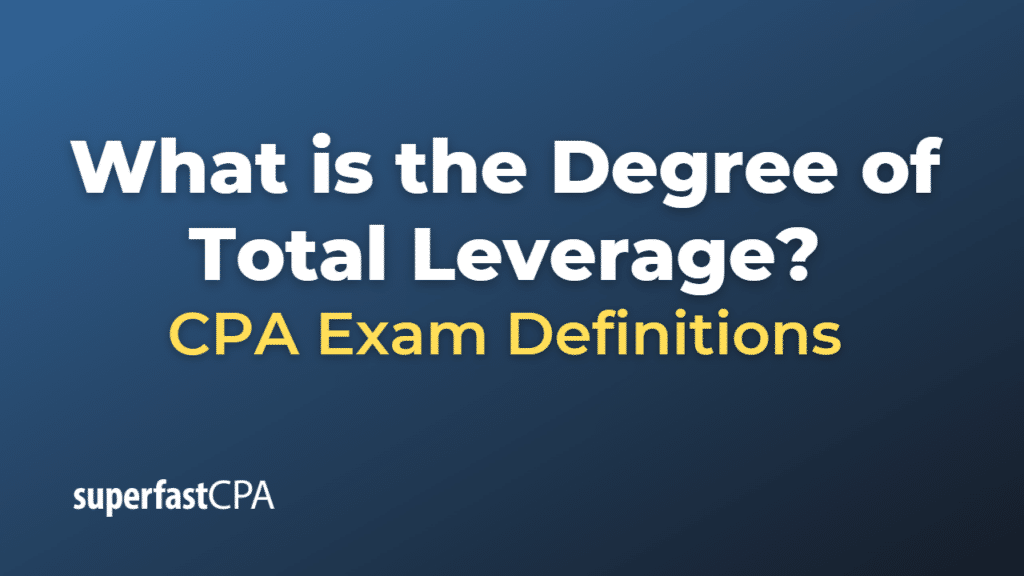Degree of Total Leverage
The Degree of Total Leverage (DTL) is a financial ratio that measures the sensitivity of a company’s earnings per share (EPS) to changes in its sales volume, considering both operating and financial leverage. It’s a measure of the overall risk of a company’s capital structure.
In other words, the Degree of Total Leverage is the multiple by which the EPS would change for a given change in sales. It combines the effects of operating leverage, which is the sensitivity of operating income (or EBIT: Earnings Before Interest and Taxes) to changes in sales due to fixed operating costs, and financial leverage, which is the sensitivity of EPS to changes in EBIT due to the use of fixed-cost sources of financing like debt.
The formula for calculating the Degree of Total Leverage at a certain level of sales is:
\(\text{DTL} = \text{Degree of Operating Leverage (DOL)} \times \text{Degree of Financial Leverage (DFL)} \)
OR
\(\text{DTL} = (\frac{\text{Contribution Margin}}{\text{EBIT}}) \times (\frac{\text{EBIT}}{\text{EBIT – Interest}}) \)
Where:
- The Contribution Margin is Sales Revenue minus Variable Costs. It represents how much each unit sold contributes to covering fixed costs and then to profit.
- EBIT stands for Earnings Before Interest and Taxes, which is a measure of a company’s operating income.
- Interest is the interest expenses on the company’s debt.
A high DTL indicates that a company has a high level of total leverage, meaning its EPS is very sensitive to changes in sales. This can lead to higher profits when sales are increasing but can also lead to larger losses when sales are decreasing. Conversely, a low DTL indicates that a company has a low level of total leverage and therefore less risk associated with changes in sales.
Example of the Degree of Total Leverage
Let’s assume that we have a company called “ToyWorld Inc.” and the following financials are given:
First, we will calculate the Contribution Margin, which is Sales Revenue minus Variable Costs: Contribution Margin = $1,000,000 – $400,000 = $600,000
Next, we find the Operating Income, or EBIT (Earnings Before Interest and Taxes), which is Contribution Margin minus Fixed Costs: EBIT = $600,000 – $200,000 = $400,000
Now, we can calculate the Degree of Operating Leverage (DOL) and the Degree of Financial Leverage (DFL):
- \(\text{DOL} = \frac{\text{Contribution Margin}}{\text{EBIT}} \)
\(\text{DOL} = \frac{\$600,000}{\$400,000} = 1.5 \) - \(\text{DFL} = \frac{\text{EBIT}}{\text{EBIT – Interest}} \)
\(\text{DFL} = \frac{\$400,000}{\$400,000 – \$50,000} = 1.14\)
Finally, we calculate the Degree of Total Leverage (DTL) which is the product of DOL and DFL:
DTL = DOL x DFL
DTL = 1.5 x 1.14 = 1.71
This means that for a 1% change in sales, the earnings per share (EPS) of ToyWorld Inc. would change by 1.71%. So, if sales increase by 10%, the EPS would increase by 17.1% (1.71 times 10%). Conversely, if sales decrease by 10%, the EPS would decrease by 17.1%.
This illustrates how total leverage can amplify the effects of sales fluctuations on a company’s earnings per share. It’s important to remember that while higher total leverage can lead to increased profits when sales are rising, it can also result in larger losses when sales are falling.













